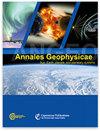How does auroral electron precipitation near the open–closed field line boundary compare to that within the auroral oval during substorm onset?
IF 1.9
4区 地球科学
Q3 ASTRONOMY & ASTROPHYSICS
引用次数: 0
Abstract
Abstract. Auroral electron precipitation during a substorm exhibits complex spatiotemporal variations which are still not fully understood, especially during the very dynamic phase immediately following the onset. Since during disturbed times the auroral oval typically extends across several hundreds of kilometers in the latitudinal direction, one may expect that precipitating electron spectra differ at locations close to the open–closed field line boundary (OCB) compared to the central part of the auroral oval. We carry out a statistical study based on 57 auroral breakups associated with substorm onsets observed above Tromsø (66.7° N geomagnetic latitude, i.e. central oval) and 25 onsets occurring above Svalbard (75.4° N geomagnetic latitude, i.e. poleward boundary) between 2015 and 2022. The events were selected based on the availability of both optical observations and field-aligned incoherent scatter radar measurements. Those are two sets of different substorms; hence we compare solar wind driving conditions and geomagnetic indices for the two event lists in the statistical sense. Using the ELSPEC method (based on the inversion of the electron density profile) on the radar data, we retrieve precipitating electron fluxes within 1–100 keV around each onset time, and we apply the superposed epoch analysis method on the electron spectra at each location. We compare the statistical precipitation characteristics above both sites in terms of peak differential flux, energy of the peak, integrated energy flux, and their time evolution during the minutes following the onset. We find that the integrated energy flux associated with events occurring in the central part of the auroral oval (Tromsø) exhibit a sharp peak up to 25 mW m-2 in the first two minutes following the auroral breakup, before decreasing and reaching stable values around 7 mW m-2 for at least 20 min. In turn, no initial peak is seen near the open–closed field line boundary (Svalbard), and values remain low throughout (1–2 mW m-2). A comparison of the median spectra indicates that the precipitating flux of > 10 keV electrons is lower above Svalbard than above Tromsø by a factor of at least 10, which may partly explain the differences. However, it proves difficult to conclude whether the differences originate from the latitude at which the auroral breakup takes place or from the fact that the breakups seen from Svalbard occur equatorward from the radar beam, which only sees expansion-phase precipitation after a few minutes.在亚暴发生期间,开闭场线边界附近的极光电子沉淀与极光椭圆内的电子沉淀相比如何?
摘要亚暴期间的极光电子沉淀呈现出复杂的时空变化,这一点尚未完全清楚,尤其是在亚暴开始后的动态阶段。由于在扰动期间极光椭圆通常在纬度方向上延伸数百公里,因此可以预计,与极光椭圆的中心部分相比,在靠近开闭场线边界(OCB)的位置,析出的电子能谱会有所不同。我们根据2015年至2022年期间在特罗姆瑟上空(地磁纬度66.7°N,即极光椭圆中部)观测到的57次与亚暴发生有关的极光破裂和斯瓦尔巴上空(地磁纬度75.4°N,即极地边界)发生的25次亚暴发生进行了统计研究。选择这些事件的依据是光学观测数据和场对齐非相干散射雷达测量数据。这是两组不同的亚暴;因此,我们在统计意义上比较了两个事件列表的太阳风驱动条件和地磁指数。在雷达数据上使用ELSPEC方法(基于电子密度剖面的反演),我们检索了每个开始时间周围1-100 keV范围内的析出电子通量,并在每个位置的电子频谱上应用了叠加历元分析方法。我们从峰值差通量、峰值能量、综合能量通量及其在起始后几分钟内的时间演变等方面比较了两个地点上空的降水统计特征。我们发现,与极光椭圆中部(特罗姆瑟)发生的事件相关的综合能量通量在极光破裂后的头两分钟内出现一个高达 25 mW m-2 的急剧峰值,然后逐渐降低,并在至少 20 分钟内达到 7 mW m-2 左右的稳定值。反过来,在开闭场线边界(斯瓦尔巴)附近没有出现初始峰值,整个过程中的数值都很低(1-2 mW m-2)。对中值光谱的比较表明,斯瓦尔巴上空的 > 10 keV 电子析出通量比特罗姆瑟上空低至少 10 倍,这可能是造成差异的部分原因。然而,很难断定这些差异是源于极光破裂发生的纬度,还是源于从斯瓦尔巴看到的破裂发生在雷达波束的赤道方向,因为雷达波束只在几分钟后才看到膨胀阶段的沉淀。
本文章由计算机程序翻译,如有差异,请以英文原文为准。
求助全文
约1分钟内获得全文
求助全文
来源期刊

Annales Geophysicae
地学-地球科学综合
CiteScore
4.30
自引率
0.00%
发文量
42
审稿时长
2 months
期刊介绍:
Annales Geophysicae (ANGEO) is a not-for-profit international multi- and inter-disciplinary scientific open-access journal in the field of solar–terrestrial and planetary sciences. ANGEO publishes original articles and short communications (letters) on research of the Sun–Earth system, including the science of space weather, solar–terrestrial plasma physics, the Earth''s ionosphere and atmosphere, the magnetosphere, and the study of planets and planetary systems, the interaction between the different spheres of a planet, and the interaction across the planetary system. Topics range from space weathering, planetary magnetic field, and planetary interior and surface dynamics to the formation and evolution of planetary systems.
 求助内容:
求助内容: 应助结果提醒方式:
应助结果提醒方式:


